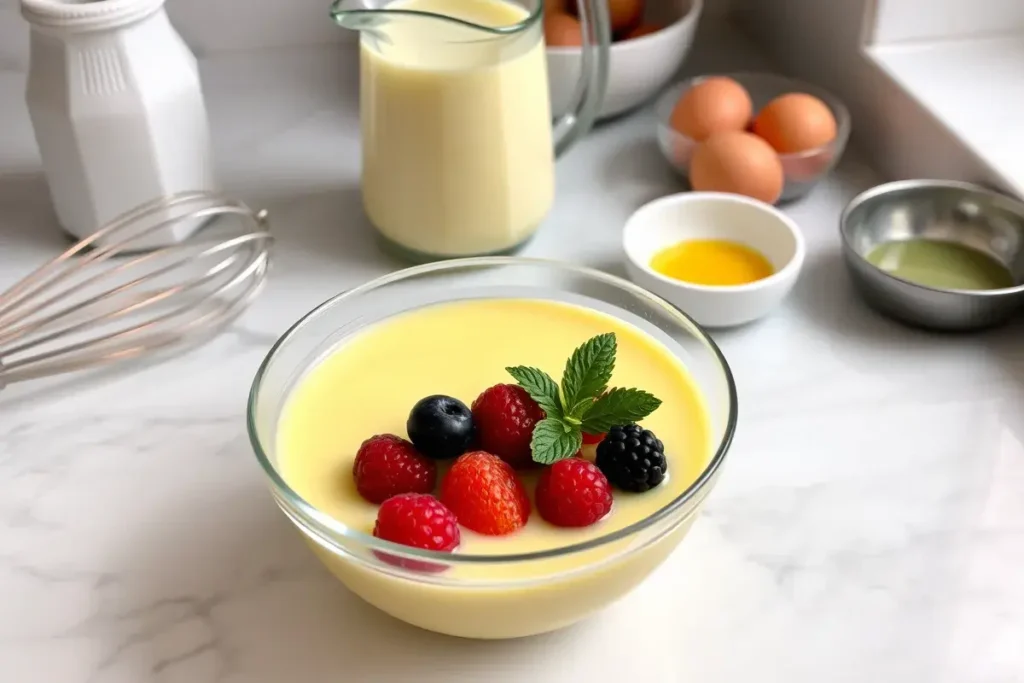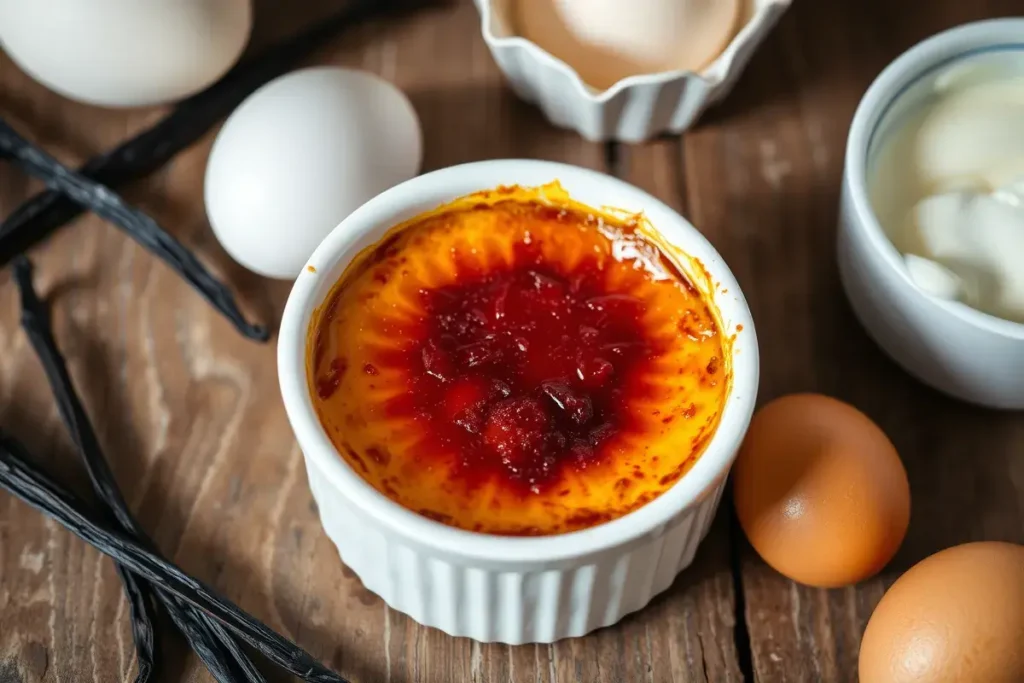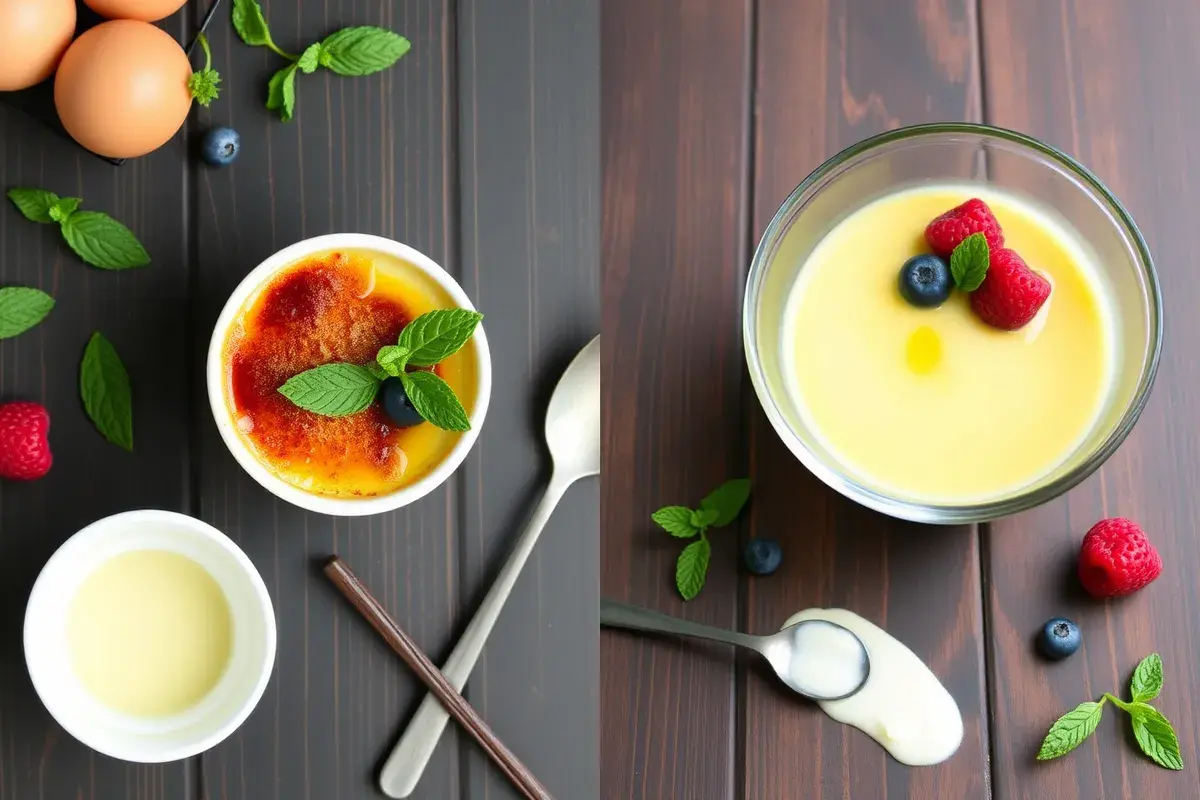Understanding the Distinction Between Crème Brûlée and Custard
Overview of Custard-Based Desserts
Custard-based desserts are a cornerstone of many cuisines, offering a creamy base for countless recipes. At their heart, custards combine milk, cream, eggs, and sugar to create a velvety, versatile delight. From baked varieties like flan to stirred custards like pastry cream, these dishes come in many forms, each showcasing unique textures and flavors.
Importance of Differentiating Between These Two Desserts
While crème brûlée and custard may seem alike at first glance, understanding their differences enriches the appreciation of both.
Crème brûlée stands out with its caramelized sugar topping, adding a delightful crunch. Custard, on the other hand, shines in its simplicity and adaptability across savory and sweet dishes. This distinction is more than culinary trivia—it’s a way to elevate your dessert expertise.
Defining Custard
What Is Custard?
Custard is a creamy, egg-based dish made by blending milk, cream, and sugar with eggs to achieve its signature rich texture. Whether sweet or savory, its versatility makes it a foundational recipe in global culinary traditions.
Basic Ingredients and Preparation Methods
The core ingredients of custard are simple: eggs, milk, sugar, and often a hint of vanilla or other flavorings. The magic lies in the method—eggs are gently heated with the other ingredients to thicken the mixture. Careful temperature control is crucial; too much heat can curdle the eggs, while too little won’t allow the custard to set. The final product should be smooth, creamy, and bursting with flavor.

Variations of Custard Across Different Cultures
Custard is a world traveler, taking on many forms depending on the region. In France, crème anglaise is a light, pourable custard served with pastries. Asian cuisines embrace steamed custards, often incorporating savory twists like soy sauce. Meanwhile, in Britain, custard is thick and often used as a topping for puddings. Its ability to blend with local ingredients ensures it has a universal appeal.
Types of Custard
Custard isn’t one-size-fits-all; it comes in a variety of textures and preparations. Each type offers something unique, catering to different tastes and uses.
Baked Custard
Baked custards, such as flan or crème caramel, are set in the oven. A water bath, or bain-marie, ensures even cooking and a silky texture. This method creates a firm but tender dish that holds its shape when plated.
Stirred Custard
Chefs cook stirred custards, like pastry cream, on the stovetop while constantly stirring them to prevent curdling. These custards stay soft and often fill tarts, éclairs, or trifles. Unlike baked custards, they do not solidify and maintain a luscious, pourable consistency.
Steamed Custard
Steamed custards are a staple in many Asian cuisines, made by steaming the egg mixture. These can be savory, like Chinese chawanmushi, or sweet, featuring ingredients such as coconut milk. The steaming process results in a delicate, almost ethereal texture.
Exploring Crème Brûlée
What Is Crème Brûlée?
Crème brûlée, often dubbed the “queen of desserts,” is a decadent custard topped with a brittle layer of caramelized sugar. Its allure lies in the contrast between the creamy custard base and the crunchy, golden topping. While seemingly simple, this dessert is a sophisticated treat that exemplifies the artistry of French patisserie.

Origins and Historical Background
The exact origins of crème brûlée are debated. Many credit its roots to France, where it became a symbol of refined dining. However, similar desserts have appeared in England and Spain under different names, such as “burnt cream” and “crema catalana.” Its popularity surged in the 19th century, solidifying its place as a classic in European cuisine.
Signature Characteristics
What sets crème brûlée apart is its distinctive caramelized sugar crust. Achieved by sprinkling sugar over the custard and torching it, this crust provides a delightful contrast to the silky base. The custard itself is usually flavored with vanilla, though variations include citrus, chocolate, or even matcha.
Preparation Techniques for Crème Brûlée
The perfect crème brûlée requires precision and care at every step. From choosing the right ingredients to mastering the final torching, each detail contributes to its success.
Ingredient Selection
Quality ingredients are key. Use fresh cream, egg yolks, and pure vanilla extract for the custard base. The sugar for the topping should be fine and even to ensure a uniform caramelization. Opting for high-quality ingredients enhances the flavor and texture.
Cooking Methods
Crème brûlée is typically baked in a shallow ramekin using a water bath. This method, much like for baked custards, ensures even cooking and prevents the eggs from scrambling. The custard is done when it jiggles slightly in the center, a sign of its creamy consistency.
Achieving the Perfect Caramelized Sugar Topping
The crowning glory of crème brûlée lies in its perfectly caramelized sugar crust, which provides both texture and visual appeal. Once the custard cools completely, chefs carefully sprinkle an even layer of fine sugar over its surface to prepare for the caramelization process.
Next, they use a kitchen torch to gently melt the sugar, transforming it into a glossy, golden-brown topping that enhances the dessert’s elegance. However, timing plays a critical role in this step. If torched for too little time, the sugar layer won’t set properly, leaving it soft and unappealing.
On the other hand, excessive torching can burn the sugar, resulting in a bitter flavor. When executed correctly, this step produces a delightful crunch that beautifully contrasts with the creamy custard base, elevating the experience of every spoonful.
Key Differences Between Crème Brûlée and Custard
Ingredient Variations
When it comes to crème brûlée and custard, the differences begin at the ingredient level. While both rely on similar base components, the details vary, creating distinct final products.
| Nutrient | Crème Brûlée (per 100g) | Custard (per 100g) |
|---|---|---|
| Calories | 300 kcal | 120 kcal |
| Protein | 4 g | 3 g |
| Fat | 22 g | 4 g |
| Saturated Fat | 13 g | 2 g |
| Carbohydrates | 25 g | 15 g |
| Sugars | 24 g | 14 g |
| Sodium | 80 mg | 40 mg |
Dairy Components
Custard typically uses a mix of milk and cream, resulting in a lighter texture, especially in variations like stirred or steamed custards. In contrast, crème brûlée leans heavily on cream, lending it a richer, silkier consistency. The higher fat content in crème brûlée not only enhances its luxurious feel but also supports its signature smooth texture.
Sweetening Agents
Sugar plays a pivotal role in both desserts, but its use varies significantly. Custards often have sugar incorporated into the mixture, balancing the sweetness evenly. On the other hand, crème brûlée takes it a step further by introducing an additional layer of caramelized sugar on top, offering a dual-texture experience.
Texture and Consistency
The textural differences between crème brûlée and custard are as apparent as their taste.
Mouthfeel and Density
Custard is known for its versatility, with textures ranging from creamy and pourable to firm and sliceable, depending on the type. Stirred custards, for instance, retain a soft, pudding-like consistency.
In contrast, crème brûlée is uniformly firm but with an exceptionally creamy interior that contrasts beautifully with the crisp sugar topping. The smooth, luxurious mouthfeel of crème brûlée is unmistakable and a hallmark of its preparation style.
Cooking Methods
The preparation methods for these desserts significantly influence their final characteristics, with distinct techniques highlighting their differences.
Baking Techniques
Chefs bake custards either directly or on the stovetop, depending on the desired type. They always bake crème brûlée in shallow ramekins to achieve its even texture. This shallow vessel allows the custard base to cook uniformly, preventing over-thickening or curdling.
Use of Water Baths
A bain-marie or water bath is essential for both desserts, but crème brûlée demands more precision. The water bath helps maintain a steady, gentle heat, crucial for achieving the custard’s creamy consistency without curdling. This step is especially critical for crème brûlée to retain its iconic texture.
Presentation and Serving Styles
The way chefs serve and present these desserts adds another layer of distinction.
Traditional Garnishes
Custards are often served with simple garnishes like a sprinkle of nutmeg or a dollop of whipped cream. Crème brûlée, in contrast, boasts a signature caramelized sugar crust as its defining feature. The crackling sound when breaking through this crust is as much a part of the experience as the taste.
Serving Temperatures
Chefs serve custard warm, chilled, or at room temperature, depending on the variety and cultural tradition. Crème brûlée, however, almost always comes cold, with the freshly torched sugar crust creating a warm contrast to the chilled custard underneath.
Cultural Significance and Popularity
Crème Brûlée in French Cuisine
Crème brûlée is not merely a dessert; instead, it stands as a true symbol of French culinary sophistication and artistry. Often referred to as “burnt cream” in English, this decadent dish has, over time, become a staple in many high-end French restaurants.
Furthermore, its long-standing association with luxury dining and refined techniques elevates crème brûlée far beyond the realm of a simple sweet treat. Instead, it offers diners a memorable and indulgent culinary experience that perfectly balances elegance and flavor.
Historically, crème brûlée became a hallmark of French patisserie in the 19th century, though its origins may predate this period. The intricate preparation and emphasis on premium ingredients highlight its deep-rooted connection to French cooking traditions. Today, it remains a top choice for celebratory meals, reflecting its enduring appeal and cultural significance.
Custard’s Role in Global Desserts
Custard boasts a broad cultural footprint, appearing in cuisines worldwide. Its adaptability lets chefs blend it seamlessly into both savory and sweet dishes. In British cuisine, people frequently pair thick custard with puddings, creating a comforting and nostalgic combination that has endured for centuries.
Moreover, this pairing often enhances the flavors of traditional British desserts, making custard an essential component of their culinary heritage. Conversely, in Asian cuisine, diners cherish unique variations such as egg tarts and steamed custards, which showcase innovative textures and delicate flavors.
Additionally, these desserts often incorporate local ingredients, like coconut milk or soy, further highlighting custard’s versatility and global appeal. This widespread appreciation underscores how custard adapts beautifully to different cultures while maintaining its universal charm.
Bakers and chefs use custard widely in baking, fillings, and standalone desserts, which highlights its versatility. Whether they layer it in a trifle or fold it into a tart, custard serves as a dessert component that transcends borders and adapts to local tastes.
Frequently Asked Questions (FAQs)
Is Crème Brûlée a Type of Custard?
Yes, crème brûlée is technically a type of custard. It shares the foundational ingredients of milk, cream, sugar, and eggs. However, its preparation and unique caramelized sugar topping distinguish it from other custards. Unlike many custards, which are often served plain or with simple garnishes, crème brûlée’s crisp sugar crust adds texture and flair.
Can Custard Be Used as a Base for Crème Brûlée?
Absolutely! In fact, the custard base of crème brûlée is what provides its creamy texture. The only difference is that the custard is baked and then topped with sugar that’s caramelized. This process transforms a simple custard into the more luxurious crème brûlée.
What Are Common Mistakes When Making These Desserts?
The most common mistakes include overcooking the custard, which can lead to a rubbery texture, or undercooking it, resulting in a runny consistency.
For crème brûlée, uneven caramelization or burning the sugar topping is a frequent mishap. Using a water bath for both desserts is crucial to avoid curdling, and precise temperature control is key to achieving the desired consistency.
How Does Flan Compare to Crème Brûlée and Custard?
Flan, which represents another custard-based dessert, closely resembles crème caramel rather than crème brûlée. Unlike crème brûlée’s crisp caramelized topping, flan features a smooth and glossy caramel sauce layer, which creates a completely different mouthfeel.
Moreover, flan typically delivers a texture that feels firmer and more structured compared to stirred custard. However, its consistency remains softer and more delicate than the creamy richness of crème brûlée. This unique balance of firmness and softness makes flan a versatile and appealing dessert for a wide range of palates.
Are There Savory Versions of Custard?
Yes, custards can take on savory forms! For example, chefs bake quiche as a savory custard, combining ingredients like cheese, vegetables, or meats in a pastry crust. Asian cuisines also feature steamed custards with savory variations, using ingredients such as soy sauce, mushrooms, or seafood to enhance their flavor.
What Equipment Is Essential for Making Crème Brûlée?
The must-have tools include shallow ramekins, a whisk for mixing the custard, and a kitchen torch for caramelizing the sugar topping. A water bath is essential for baking, ensuring the custard cooks evenly. For custards in general, a good thermometer is invaluable for monitoring temperatures and preventing curdling.
Summarizing the Differences Between Crème Brûlée and Custard
Crème brûlée and custard both rely on a common foundation of eggs, milk, cream, and sugar, yet their unique characteristics distinguish them. Crème brûlée features a rich custard base and a caramelized sugar crust, which creates a delightful contrast between creamy and crunchy textures.
Custard, on the other hand, offers a broader spectrum of styles, ranging from baked to stirred to steamed, showcasing its versatility in both sweet and savory dishes.
When it comes to preparation, crème brûlée demands a more intricate approach, requiring precise baking and the iconic sugar torching. Custard, in its many forms, is more forgiving and adaptable, making it a staple in cuisines worldwide.z
In terms of presentation, crème brûlée immediately stands out due to its elegant caramelized sugar topping, which adds both texture and visual appeal. Additionally, it is typically served in shallow ramekins, emphasizing its sophisticated and individual portions.
On the other hand, custard varies greatly in appearance depending on the specific dish in which it is featured. For example, it can range from smooth and pourable sauces, which are perfect for drizzling, to firm and sliceable textures, ideal for layered desserts.
This versatility not only highlights custard’s adaptability but also proves its enduring value in a variety of culinary creations.
Ultimately, the difference between crème brûlée and custard lies in their textures, preparation methods, and cultural significance. While both are undeniably delicious, each offers a unique experience. Crème brûlée is the epitome of luxury and indulgence, while custard showcases comforting simplicity and versatility.
For more inspiration and creative ideas, don’t miss our latest article:”Crab Brulee“. It’s packed with fresh recipes and tips to make your cooking experience even more enjoyable!”
For more inspiration and creative ideas, don’t miss our latest article:”How to Caramelize Brûlée“. It’s packed with fresh recipes and tips to make your cooking experience even more enjoyable!”

